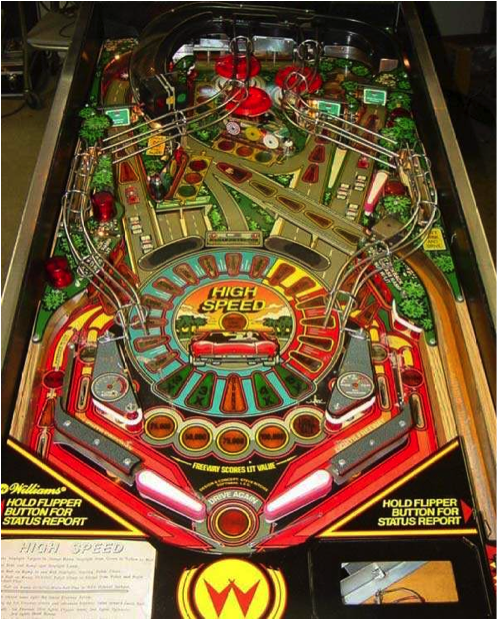(Average Reading Time: 6 minutes, 30 seconds)
written by Helen Maupin and David ZingerImagine a 20th century pinball machine complete with its delightful “bells and whistles” ringing in your ears while you chalk up points manipulating a silver ball through a chaotic path of opportunities and obstacles. Now imagine two of these machines with two players but only one ball travelling back and forth between the two machines.
This is what happened when I shared breakfast with David Zinger, employee engagement expert and host of the 6300 member Employee Engagement Network — mental pinball — two minds rolling chaotically through a series of touch points until we, sometimes individually, sometimes collectively, often both, fell upon a breakthrough connection — And isn’t this an apt metaphor illustrating the creative process. We just about flipped!
On this particular day, our pinball wizardry led us to maneuver around the concept of business models — practical techniques for value creation. In its scientific definition, a successful business model is meant to deepen your understanding of your customers, distribution channels, partners, revenue streams, costs as well as your core value proposition. However, we all know there is both an art and a science to running a business, and like true creators our thoughts turned to the artful side of business modeling.
We were amused to discover we both have a three-letter acronym defining our business artistry. David is going to jump into this blog in a few paragraphs and tell you about his artful acronym — ICE. In the meantime, I will regale you with my acronym — aaa (or ‘eh’ — a little Canadian comic relief and also a bit of a recovery group known as the American Automobile Association).
All knowledge is self-knowledge. Socrates
Awareness. As Socrates’ principle implies, to know life is to know oneself. In more contemporary language, the world without is a reflection of the world within. Therefore, becoming aware of one’s inner experience (sensations, thoughts, emotions) allows us to understand and adapt our responses to emerging events. This shared journey of discovery, between our awareness and the subtle sensations within our body, reveals the truth beneath the surface appearance of thoughts and emotions. Herein, lies the pathway to wisdom and enlightenment.
For the most part what appears in our lives gets coloured by our judgments about pain and pleasure. In seeking pleasure, we may find ourselves becoming overly attached to food, money, people, thrills, etc., all of which distract us from the truth — that which is actually being presented to us. Similarly, in our avoidance of pain, we continually run away from or resist what we perceive as painful rather than explore and resolve ourselves of the pain.
By training our awareness to see beneath the surface of our sensations, thoughts and emotions, we guide ourselves to the knowledge of how life works — its governing dynamics. In this way, we discern the real truth from the judgment-coloured truth of our conditioned perceptions. As a practical business application, we are able to see the early signs of trends emerging in the marketplace and strategize accordingly.
Things are as they are.
Looking out into the universe at night
we make no comparisons between right and wrong stars,
nor between well and badly arranged constellations.
Alan Watts
Acceptance. Fortunately, through releasing our attachments and aversions, life provides us with ample opportunity to practice accepting what is. Why is this vital? Without acceptance, we cannot live fully and positively in the present moment. Regretting our past actions or worrying about the future takes us out of the present and away from mindful living. Living in our memories and fantasies is how we practice aversion and attraction. Releasing our attachments and aversions means accepting what arises without judgment.
Everything is what it is until we label it right or wrong, good or bad, interesting or boring, sad or happy, opportunity or obstacle, friend or foe. Pema Chodron reminds us what we typically regard as obstacles or enemies are really our teachers and friends. By the way, no “obstacle” ever goes away until we learn what we need in order for us to no longer hesitate or avoid it.
Discernment — being aware of pleasant, unpleasant or neutral experiences — teaches us to become “at home” with and accept the present moment as it is. Seeing without judgment allows us to see under the surface of what appears to be pleasant, unpleasant or neutral. We apply this in business by channeling our mental, emotional and physical energy in directions that fulfill and sustain. For instance, most artists dread the words marketing and sales. In discerning this previous aversion, I now design “fun and creative” marketing and sales activities.
Grant me the serenity to accept the things I cannot change,
the courage to change the things I can,
and the wisdom to know the difference.
Serenity Prayer
Action. Action requires courage and compassion particularly in today’s world of uncertainties and unknowns. It is the everyday courageous choice of compassionate actions inspired by our insight and intuition, not impulse, that defines the hero’s journey. IMHO, the journey through life is the opportunity to discover and grow the hero within each of us. Plagued with such ‘wicked’ global problems as poverty, climate change, equality, healthcare, nuclear energy and even business strategy, we need en masse heroic thoughts and actions to resolve what touches us all but is proving difficult to solve independent of each other. Applying this heroic principle in life and business, remains as simple as asking “What would courage and compassion look like in this situation?” Simple to ask, but not easy to act upon.
Let me leave you with those thoughts as I’m curious to read about David’s heroic ICE making, so let’s flip the pinball over to his capable hands.
I loved playing pinball. It was a game with color, noise, points, and the danger of tilting. It had a wonderful mix of randomness fused with some sense of control and the purpose was to keep the game going. If you got good you touched sustainability in pinball by getting free balls, longer play with each ball, and ultimately more free games. The reward of the game was simply more of the game. And although you could rack up points in many ways the activity was pointless.
Three keys from my conversation with Helen were ICE, you want to be cool when you play pinball. ICE stands for Intention, Connection, and Engaged Empathy.
I have lived my life and worked my work not with goals but with intentions. I never seemed smart enough to figure out a goal and move towards it but I could travel the path of intention, bump into something, and make a valuable and worthwhile course correction. I believe intention is embedded within each moment and it is ours to experience, express, discover, and enliven. Intention helps us move closer to meaning. Be one with the machine or one with the customer. Simply making money may be an impoverished intention for running a business if you are willing to allow intention to rise up from your core and be expressed in all you do.
Connection is the key. Connection is another word for engagement. We can connect to people and connect to results. My best pinball occurred when I found a still point within myself that connected me to the machine. Only many years later did I have words to describe it like flow and the zone. How connected are you to your business? How connected are you to the people in your business both inside the business and outside the business? A bit like finding T. S. Eliot’s still point in the changing world:
Neither from nor towards; at the still point, there the dance is,
But neither arrest nor movement. And do not call it fixity,
Where past and future are gathered. Neither movement from nor towards,
Neither ascent nor decline. Except for the point, the still point,
There would be no dance, and there is only dance.
I can only say, there we have been: but I cannot say where.
And I cannot say, how long, for that is to place it in time.
Engaged Empathy. I love empathy. Not so much the feeling but the experience and engaged empathy is best. One of my favorite teaching moments occurred in a counselling course 20 years ago. I had a mechanical engineer in the course. His specialty, that had him in demand around the world, was to “fix” sick buildings. He often believed it was airflow challenges and his first way of working involved having “empathy” for the building, imagining himself as the airflow and then identifying challenges and blocks. I have always had empathy for people but he taught me an engaged empathy beyond people to even the mechanical world. I realized a lot of my joy with pinball was the empathy I experienced in being so connected to the machine.
Making ICE. Yes, that was a theoretical outline of some minor epiphanies from a conversation with Helen. You don’t have to use our acronyms. In fact, I think that would be a terrible mistake. I want you to make your own ICE by taking what we wrote and get playful with how you both see and experience yourself and your work.
Thank you, David, for this fun and creative look at the art of life and business modeling. Now I want to flip the pinball over to you, the reader. What is your action “model” for life and business?
For those of who also love pinball, Ken in Texas tells me that one of the largest shows in the country — the Texas Pinball Festival — runs March 28-30, 2014. Check it out.





